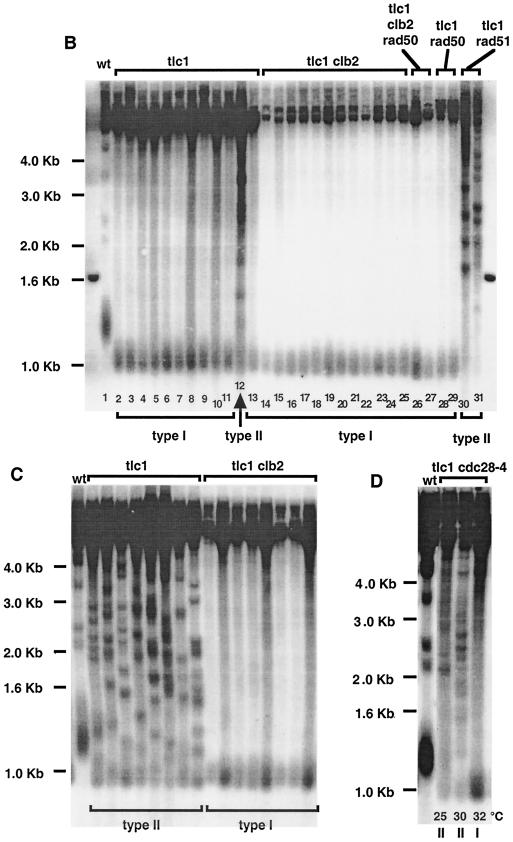FIG. 1.
Clb2 is required for the generation of type II postsenescence survivors. (A) Cell viability in various telomerase-deficient strains of the indicated relevant genotypes during and after senescence. The trough of each viability curve indicates crisis, after which viability readily reincreases due to the onset of homologous recombination-based mechanisms that repair the eroded telomeres. A noticeable exception is the tlc1 rad51 clb2 triple mutant, which, under these conditions, could not recover from senescence. Cells were grown in liquid cultures at 29°C and diluted every 24 h to 105 cells/ml with fresh medium (see Materials and Methods). Two additional experiments gave similar results. (B) Clb2 inhibits the generation of type II survivors in streak assays (see Materials and Methods). Colonies emerging from senescing cultures of tlc1Δ clb2Δ or tlc1Δ CLB2+ strains grown on agar plates at 29°C were picked out, individually grown overnight in liquid, and harvested. In such samples, type I recombination can be conveniently distinguished from type II recombination by analyzing Southern blots from genomic DNA previously cut with XhoI. Classical criteria were used to determine formation of type I versus type II survivors (56, 58). Thus, type I survivors are characterized by the erosion of telomeres compared to wild-type (wt) cells (compare lanes 1 and 2; the mean size of the terminal telomere tracts in the wild type corresponds to the broad band at ∼1.3 kb), with the XhoI site within telomeres being located more distal than the Y′ sequences, while type II survivors exhibit very long and heterogeneous TG1-3 sequences (located more distal than the XhoI site) (lanes 12, 30, and 31). The disappearance of the four bands migrating at ∼2.1, 2.3, 3.4, and 4.2 kb in the nonrecombining cells (lane 1), representing non-Y′ fragments from the non-Y′ chromosomes, attests to the fact that these type I survivors have indeed undergone recombination. Exclusive type I survivors from tlc1Δ clb2Δ rad50Δ (lanes 26 and 27) and tlc1Δ rad50Δ (lanes 28 and 29) mutants and type II survivors from a tlc1Δ rad51Δ mutant (lanes 30 and 31) are shown for comparison. Southern blots were revealed with a 270-bp TG1-3 32P-labeled probe. (C) Clb2 is required for the transition from type I to type II that naturally occurs in liquid cultures, due to the better growth of type II survivors (56). Eight individual tlc1Δ and tlc1Δ clb2Δ survivors each were propagated for ∼100 generations as exponentially growing liquid cultures (at 29°C) that were diluted to 105 cells/ml every day, and their survivor type was determined as described above. XhoI cutting and a TG1-3 32P-labeled probe were used. (D) Full function of Cdc28 is required for the transition from type I to type II, under the same conditions as described above for tlc1Δ clb2Δ cells (daily dilutions of 105 cells/ml, ∼100 generations of growth), but here at either 25, 30, or 32°C (cdc28-4 is a temperature-sensitive allele of CDC28).


